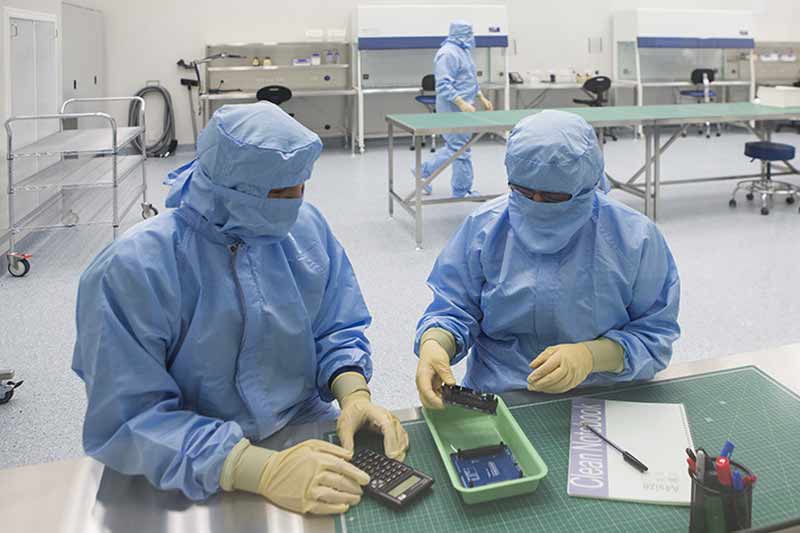
Above photo: Inside the ANU Advanced Instrumentation Technology Centre at Mount Stromlo Observatory/ Credit: Stuart Hay, ANU
While the Australian federal government committed to establishing a national space agency, the University of New South Wales (UNSW) Canberra and the Australian National University (ANU) entered into an agreement to collaborate on building and testing satellites and space instruments. (Media releases from ANU and UNSW available here and here respectively.)
The collaboration between the two universities will provide joint access to world-class facilities at UNSW Canberra Space and ANU’s Advanced Instrumentation Technology Centre (AITC) and end-to-end capability for mission and payload design, assembly and testing. The MOU between AITC and UNSW Canberra was signed at the International Astronautical Congress in Adelaide.
UNSW Canberra brings to the agreement its space engineering expertise and Australia’s first Concurrent Design Facility. The Concurrent Design Facility, partly funded by the ACT Government, will also partner with the French space agency, CNES.
The UNSW Canberra team includes 40 highly skilled Australian space professionals from the global space sector. This includes scientists, engineers, faculty staff, postdocs and PhD students, who bring more than 150 years of experience in organisations such as the European Space Agency (ESA) and National Aeronautics and Space Administration (NASA) of the US – where they designed, developed and deployed spacecraft and space instrumentation for near-Earth and deep space programs.
UNSW Canberra Space already provides valuable research and technology to support national services, including Defence. UNSW Canberra’s space program has five satellites confirmed.
ANU is home to the Advanced Instrumental Technology Centre (AITC) at Mount Stromlo, which is a national centre which helps design, build and test satellites and space sensor systems. The AITC has Australia's most sophisticated space testing facility, including complex equipment that can reproduce the vibration shock of rocket launches and the temperature extremes experienced in the vacuum of space. AITC has a history of more than 30 years participating in major international space missions.
The AITC also builds world leading instruments for telescopes including the Skymapper Telescope at Siding Spring Observatory which is exploring and mapping the entire southern sky. It is led by Professor Anna Moore who brings a wealth of knowledge from her time at Caltech (California Institute of Technology).
ANU also has the Mount Stromlo Observatory and the ANU Research School of Astronomy and Astrophysics (RSAA), where ANU Vice-Chancellor Professor Brian Schmidt AC conducted his Nobel-Prize winning research into the expanding Universe.
ANU is a partner in the Giant Magellan Telescope project and has collaboration agreements with the European Southern Observatory, as well as close associations with leading research institutions and space agencies around the world.
ANU also hosts a AU$20 million Cooperative Research Centre which is tracking and cleaning up hundreds of thousands of pieces of space debris which orbit Earth and pose serious risks of collision with satellites, space stations and other space craft. Project partners include the Mount Stromlo-based EOS Space System, Lockheed Martin, NASA Ames Research Centre, Japan's National Institute of Information and Communications, Optus and RMIT.
ANU Professor Christine Charles has led long-running research into plasma propulsion for space craft, while ANU physicists and engineers are contributing to the laser range-finding instruments for a space mission led by NASA and the German Space Agency DLR.
ANU scientists from the Research School of Earth Sciences have also worked on rocks from the Moon and with data from the Mars Curiosity Rover.
AITC Director, Professor Anna Moore, said aligning the skills of the ANU-AITC and UNSW Canberra Space teams will help enable the future of Australia's space industry. "As a part of our mission as a National university, the AITC establishes these strategic partnerships to focus the facilities and talent Australia needs to build its own domestic space industry," Professor Moore said.
"This endeavour will provide a significant new pathway to answering important questions in environmental science, defence, space physics and astronomy.”
Dr Doug Griffin, Space Mission Lead at UNSW Canberra Space, said: "Space is a big industry, it is complicated and requires a diverse, yet unique set of skills. The UNSW Canberra agreement with ANU means Australia now has the facilities to come up to speed with the international space sector."
"This agreement also helps create the right environment in the ACT for space engineering to grow and deliver commercial operations. The UNSW Canberra commercial spin-off Skykraft will provide commercial services to a growing space sector, drawing on the research at UNSW Canberra Space. So, our UNSW Canberra space partnerships will service not only our teaching and research, but will feed right through to supporting national needs and commercial opportunities. These agreements provide new employment pathways for university graduates, while positioning Canberra right at the heart of the national space industry," said Professor Russell Boyce, Director of UNSW Canberra Space.
















